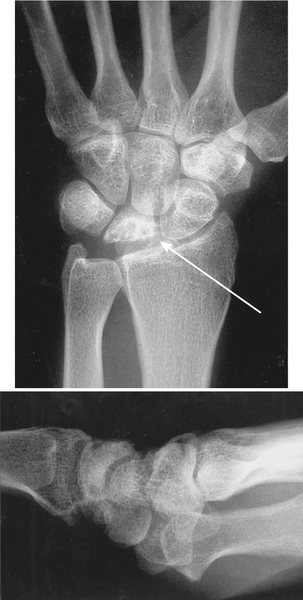CHAPTER 35
Kienböck Disease
Definition
Kienböck disease is avascular necrosis of the lunate, unrelated to acute fracture, often leading to fragmentation and collapse. Although the precise etiology and natural history of this disorder remain unknown, interruption of the blood supply to the lunate is undoubtedly a part of the process. Trauma has been implicated as a cause [1–3]. This disease occurs most often in the dominant hand of men in the age group of 20 to 40 years. Many of these patients are manual laborers who report a history of a major or repetitive minor injury. Associations have also been made between Kienböck disease and corticosteroid use, cerebral palsy, systemic lupus erythematosus, sickle cell disease, gout, and streptococcal infection.
An important radiographic observation has been made regarding the radius-ulna relationship at the wrist and the development of Kienböck disease [4]. In these patients, the ulna is generally shorter than the radius, a finding termed ulnar negative (or minus) variance. Normally, the lunate rests on both the radius and the triangular fibrocartilage complex covering the ulnar head. It has been speculated that when the ulna is significantly shorter than the radius, a shearing effect occurs in the lunate, which can make it more susceptible to injury.
Symptoms
Presenting symptoms include chronic wrist pain, decreased range of motion, and weakness [5]. The pain is usually deep within the wrist, although the patient often points to the dorsum of the wrist, and is aggravated by activity. Some patients complain of a pressure-like pain that may awaken them. A history of recent trauma is often provided; however, many patients report having had long-standing mild wrist pain preceding the recent injury. Symptoms may often be present for months or years before the patient seeks medical attention.
Physical Examination
Mild dorsal wrist swelling and tenderness in the mid-dorsal aspect of the wrist may be present. Wrist flexion and extension are limited. Forearm rotation is usually preserved. Grip strength is often considerably less on the affected side because of pain.
Neurologic and vascular examination findings are normal.
Functional Limitations
Functional limitations include difficulty with heavy lifting, gripping, and activities involving the extremes of wrist motion. Many heavy laborers are unable to perform the essential tasks required of their occupation.
Diagnostic Studies
The initial diagnostic imaging for suspected Kienböck disease includes standard wrist radiographs. Early in the disease process, the radiographs may be normal. With time, a characteristic pattern of deterioration occurs, beginning with sclerosis of the lunate, followed by fragmentation, collapse, and finally arthritis [6,7] (Fig. 35.1). A radiographic staging system for Kienböck disease, proposed by Lichtman, is helpful in describing the extent of the disease and guiding treatment [1] (Table 35.1).

Table 35.1
Stages of Kienböck Disease
| Stage I | Normal radiographs or linear fracture |
| Stage II | Lunate sclerosis, one or more fracture lines with possible early collapse on the radial border |
| Stage III | Lunate collapse |
| IIIA | Normal carpal alignment and height |
| IIIB | Fixed scaphoid rotation (ring sign), carpal height decreased, capitate migrates proximally |
| Stage IV | Severe lunate collapse with intra-articular degenerative changes at the midcarpal joint, radiocarpal joint, or both |
For clinical suspicion of Kienböck disease with normal radiographs, a technetium bone scan or magnetic resonance imaging (MRI) may be helpful. In fact, MRI has supplanted plain radiography for the detection and evaluation of the early stages of Kienböck disease when there has been no trabecular bone destruction. Characteristic signal changes include decreased signal on T1-weighted and increased signal on T2-weighted images (Fig. 35.2). Computed tomography is more effective than MRI in assessing for fracture of the lunate, but it provides limited information about its vascularity (Figs. 35.3 and 35.4).







